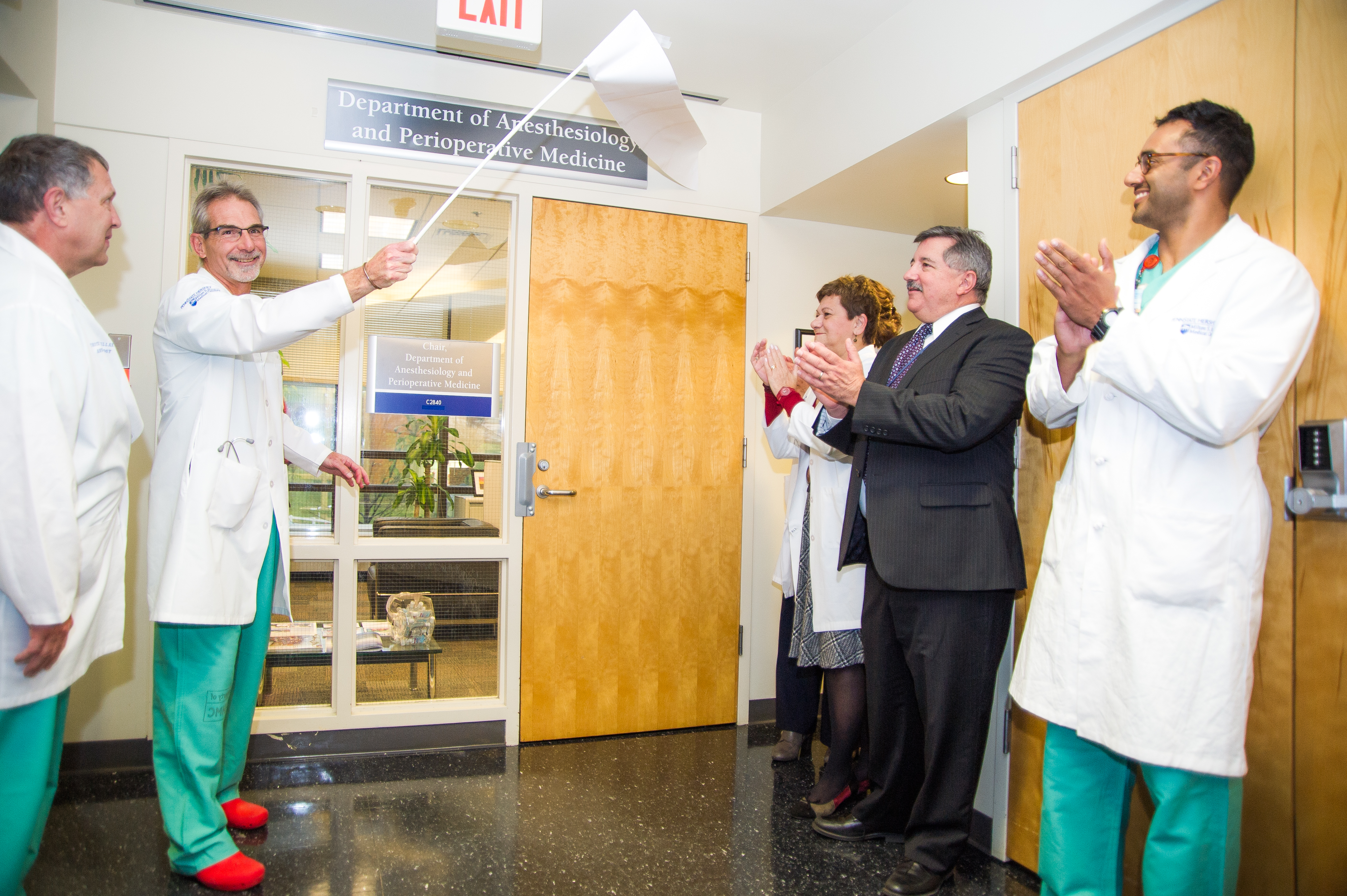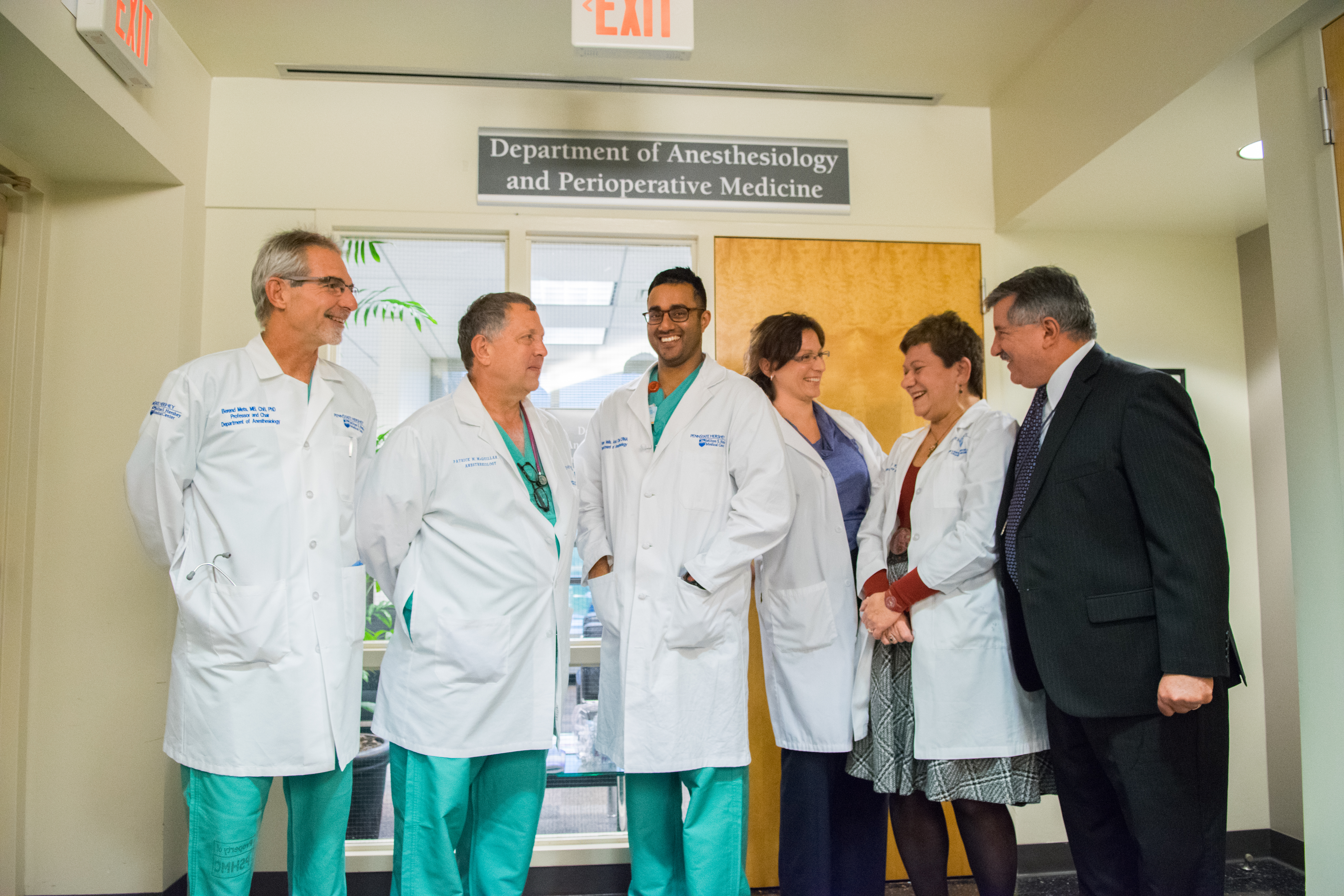Department name change recognizes expanding role of anesthesiologists

Dr. Berend Mets, chair, unveils the Department of Anesthesiology and Perioperative Medicine’s new sign,
It used to be that the only time you would see an anesthesiologist was in the operating room to help control your pain levels while undergoing surgery. Today’s practice of pain medicine looks much different, with anesthesiologists more involved in medical care before, during and following surgery. One of the ways a growing group of health care organizations in the nation—including Penn State Hershey—is formally acknowledging this expanding role by changing how anesthesiology practitioners are referenced.
At Penn State Hershey, the Department of Anesthesiology has been renamed the Department of Anesthesiology and Perioperative Medicine.
Other early adopters who have expanded their department’s name include the University of California Irvine, Oregon Health & Science University and Stanford University.
Dr. Berend Mets recently co-authored an editorial in the journal Anesthesiology with fellow chairs of these departments calling for the specialty to be renamed nationally.
“Ever since we gave the first anesthetic in 1846, anesthesiologists have been doing more and more work outside of the operating room,” Mets says. “Anesthesia has developed from being an operating-room based specialty to one which encompasses the whole of perioperative medicine, which is the medical care of patients undergoing surgery.”
Including perioperative medicine in the specialty title reflects the natural evolution of the discipline over the past 50 years, Mets says.
Anesthesiologists’ central role remains to provide a medically induced reversible coma in patients undergoing surgery–what many people erroneously call “putting you to sleep.” During surgery, anesthesiology physicians and nurses, administer anesthetics, carefully monitor patients and medically manage them until the operation is complete. After recovery from the anesthetic, anesthesiologists continue to medically manage the patients recovery in the post anesthesia care units (PACU) and then often in the intensive care unit afterwards.

A special event was held to unveil the Department of Anesthesiology’s new name: Department of Anesthesiology and Perioperative Medicine. From left, Dr. Berend Mets, Eric A. Walker Professor and chair; Dr. Patrick McQuillan, professor of anesthesiology and pediatrics, vice chair, clinical affairs, director, pediatric anesthesia; Brian Vells, CRNA, assistant chief nurse anesthetist; Dr. Jill Eckert, associate professor, vice chair, residency and education, program director, residency program, rotation director, pain medicine division; Dr. Sonia Vaida, professor, anesthesiology and obstetrics and gynecology, vice chair, research, director, OB anesthesia; and Michael Bahry, administrative operations director.
“A patient’s blood pressure may change. They may need extra fluids. Or they may need pain medications,” Mets says.
When patients are very sick, they are transferred from the PACU to an intensive care unit, where anesthesiologists may continue to care for them.
“In an ICU, you’re managing any aspect of organ failure, and this could be cerebral respiratory, cardiac, liver or kidney failure,” Mets says. “All of these medical conditions may need to be addressed in the ICU after surgery, and often that is done by anesthesiologists because we’re highly knowledgeable about the whole spectrum of perioperative medical care.”
Physician anesthesiologists also see patients in the preoperative evaluation clinic, where they ensure that co-existing medical conditions, like high blood pressure and diabetes, are optimized before surgery.
Mets has served as president and on the executive committee of the Society of Academic Anesthesiology Associations. A survey sent out to the group’s membership found that 91 percent of respondents were in favor of an official name change to include perioperative medicine.
Mets says several other professional and academic groups–the American Society of Anesthesiologists, the American Board of Anesthesiologists and the American College of Graduate Medical Education–must agree in order for the change to become widespread.
“The editorial we wrote unlocked a national discussion,” he says. “We’ve had multiple discussions at our national meetings last fall about the potential for realizing this going forward.”

The editorial also called for additional perioperative medical training for anesthesia residents. Already, about 50 percent of residents’ training is outside of the operating room.
“Anesthesia is actually a very small part of what we do and what we teach, we spend a great deal of our time medically managing patients,” Mets says. “The name change is partly a realization of where we are, but it’s also a vision of where we need to go.”
-Jennifer Abbasi
If you're having trouble accessing this content, or would like it in another format, please email the Penn State College of Medicine web department.
